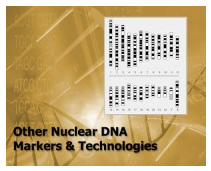Archival Notice
This is an archive page that is no longer being updated. It may contain outdated information and links may no longer function as originally intended.
Home | Glossary | Resources | Help | Contact Us | Course Map
Introduction
It is a routine for the forensic scientist to obtain a genetic profile of an individual from nuclear DNA recovered from a biological stain deposited at the crime scene. Potential contributors of the stain must either be known to investigators and compared to a known profile or searched against a database of DNA profiles, such as those maintained in the Combined DNA Index System (CODIS).
This module describes various techniques, including single nucleotide polymorphisms (SNPs), Y-STRs, low copy number (LCN), and non-human DNA. These methods can be used to obtain more probative investigative information and may be used as an adjunct to standard autosomal short tandem repeat (STR) analysis. In some cases, information is provided that otherwise could not be obtained by standard techniques.
Certain factors may preclude the development of genetic profiles despite the presence of probative biological material in a crime stain because:
- The quantity of DNA present is below the detection limit
- and/or -
- The DNA is partially degraded, such that the number average molecular weight is less than the STR amplimer sizes
Potential remedies include:
- Low copy number (LCN) analysis techniques for minute quantities of DNA
- SNP typing for partially degraded DNA
In mixed male/female specimens, Y-chromosome specific systems are invaluable for the identification of the genetic profile of the male component in the following instances:
- The female portion is present in overwhelming quantities relative to the male
- The standard autosomal STR analysis fails to yield the male donor profile
In cases where there is no developed suspect and no match with a database sample as yet, the DNA profile presently provides no meaningful information to investigators, with the notable exception of gender determination. In these situations, it would be advantageous to law enforcement investigators if additional information could be obtained from the biological stain. SNP analysis using specially selected markers can be predictive of ethno-geographic ancestry; this is expected to play an increasing role in the investigation of crime.
Another area that will contribute to the crime scene investigation is non-human DNA analysis. As techniques are developed they will become more commonplace in forensic biology.
Additional Online Courses
- What Every First Responding Officer Should Know About DNA Evidence
- Collecting DNA Evidence at Property Crime Scenes
- DNA – A Prosecutor’s Practice Notebook
- Crime Scene and DNA Basics
- Laboratory Safety Programs
- DNA Amplification
- Population Genetics and Statistics
- Non-STR DNA Markers: SNPs, Y-STRs, LCN and mtDNA
- Firearms Examiner Training
- Forensic DNA Education for Law Enforcement Decisionmakers
- What Every Investigator and Evidence Technician Should Know About DNA Evidence
- Principles of Forensic DNA for Officers of the Court
- Law 101: Legal Guide for the Forensic Expert
- Laboratory Orientation and Testing of Body Fluids and Tissues
- DNA Extraction and Quantitation
- STR Data Analysis and Interpretation
- Communication Skills, Report Writing, and Courtroom Testimony
- Español for Law Enforcement
- Amplified DNA Product Separation for Forensic Analysts


